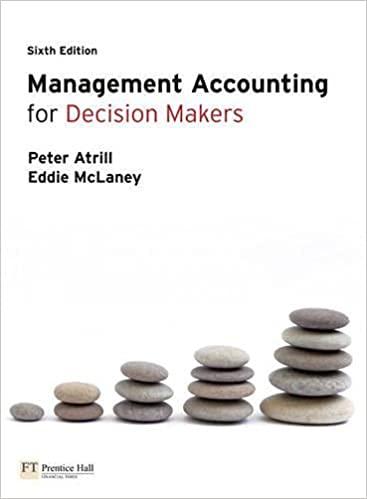Question
Asset acquisition vs. stock acquisition (fair value is different from book value) The following financial statement information is for an investor company and an investee
Asset acquisition vs. stock acquisition (fair value is different from book value) The following financial statement information is for an investor company and an investee company on January 1, 2016. On January 1, 2016, the investor companys common stock had a traded market value of $35 per share, and the investee companys common stock had a traded market value of $31 per share.
| Book Values | Fair Values | |||
|---|---|---|---|---|
| Investor | Investee | Investor | Investee | |
| Receivables & inventories | $150,000 | $75,000 | $135,000 | $67,500 |
| Land | 300,000 | 150,000 | 450,000 | 225,000 |
| Property & equipment | 337,500 | 150,000 | 375,000 | 195,000 |
| Trademarks & patents | 225,000 | 120,000 | ||
| Total assets | $787,500 | $375,000 | $1,185,000 | $607,500 |
| Liabilities | $225,000 | $120,000 | $270,000 | $142,500 |
| Common stock ($1 par) | 30,000 | 15,000 | ||
| Additional paid-in capital | 420,000 | 225,000 | ||
| Retained earnings | 112,500 | 15,000 | ||
| Total liabilities & equity | $787,500 | $375,000 | ||
| Net assets | $562,500 | $255,000 | $915,000 | $465,000 |
Required (Parts a. and b. are independent of each other.) a. Assume that the investor company issued 14,250 new shares of the investor companys common stock in exchange for all of the individually identifiable assets and liabilities of the investee company. The financial information presented, above, was prepared immediately before this transaction. Provide the Investor Companys balances (i.e., on the investors books, before consolidation) for the following accounts immediately following the acquisition of the investees net assets:
| Receivables & Inventories |
|
| Land |
|
| Property & Equipment |
|
| Trademarks & Patents |
|
| Investment in Investee |
|
| Goodwill |
|
| Total Assets |
|
| Liabilities |
|
| Common Stock ($1 par) |
|
| Additional Paid-In Capital |
|
| Retained Earnings |
|
| Total Liabilities and Equity |
|
b. Assume that the investor company issued 14,250 new shares of the investor companys common stock in exchange for all of the investee companys common stock. The financial information presented, above, was prepared immediately before this transaction. Provide the Investor Companys balances (i.e., on the investors books, before consolidation) for the following accounts immediately following the acquisition of the investees net assets:
| Receivables & Inventories |
|
| Land |
|
| Property & Equipment |
|
| Trademarks & Patents |
|
| Investment in Investee |
|
| Goodwill |
|
| Total Assets |
|
| Liabilities |
|
| Common Stock ($1 par) |
|
| Additional Paid-In Capital |
|
| Retained Earnings |
|
| Total Liabilities and Equity |
|
Step by Step Solution
There are 3 Steps involved in it
Step: 1

Get Instant Access to Expert-Tailored Solutions
See step-by-step solutions with expert insights and AI powered tools for academic success
Step: 2

Step: 3

Ace Your Homework with AI
Get the answers you need in no time with our AI-driven, step-by-step assistance
Get Started


